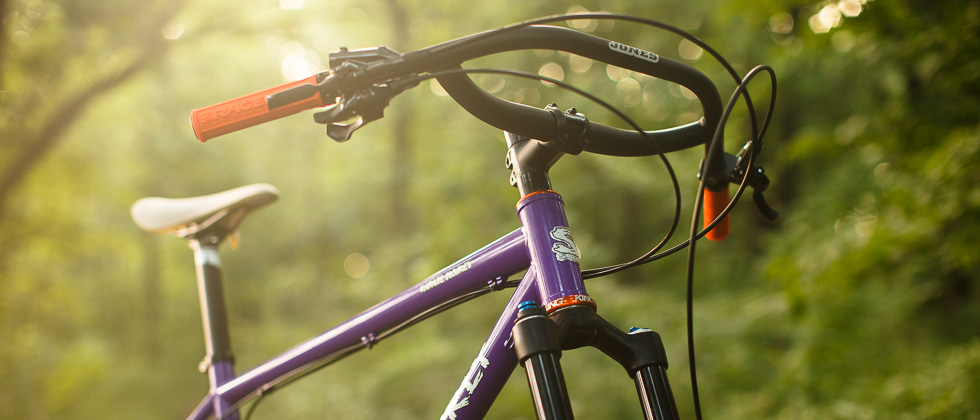To prepare for spring cycling in 2025, start by inspecting your bike; check tires, brakes, and tighten all bolts. Choose moisture-wicking layers and a quality rain jacket to stay dry. Incorporate strength training and core exercises into your routine to enhance posture and power. Gradually increase your ride distances to build endurance without overexerting. With these tips, you’re all set to hit the road and enjoy the trails, and more insights await you just ahead.
Key Takeaways
- Inspect and maintain your bike regularly to ensure optimal performance, including tire checks and brake tests.
- Dress in layers with moisture-wicking fabrics and carry a waterproof jacket for unpredictable spring weather.
- Gradually increase your ride distance by no more than 10% each week to build endurance safely.
- Incorporate strength training and cross-training exercises to enhance overall cycling fitness and prevent injuries.
- Schedule regular long rides to practice pacing strategies and allow for adequate recovery between sessions.
Preparing Your Bike for Spring Riding

As you gear up for spring riding, it’s crucial to guarantee your bike is in top shape.
Start by inspecting your tires for cracks or slits, inflating them to the manufacturer’s suggested pressure (PSI) for peak performance and safety.
Use a torque wrench to check and tighten all bolts according to specifications, preventing any annoying squeaks.
Clean your bike’s frame with mild soap and water, looking for cracks or defects during the process.
Don’t forget to test your front and rear brakes; listen for any rubbing noise from the brake pads.
Finally, refresh your tubeless tires by adding new sealant, or consider switching to tubeless to help prevent flats during your spring rides.
Proper preparation sets you up for a safe cycling season!
Essential Clothing and Layering Strategies
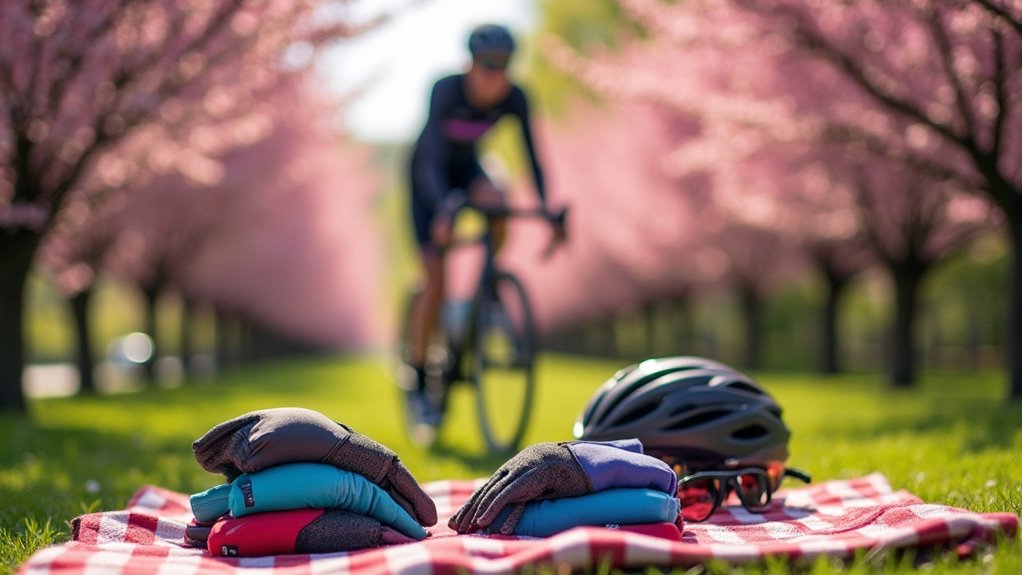
How can you stay comfortable on your spring rides despite the unpredictable weather? Layering is key. Start with a moisture-wicking base layer made from performance fabrics or Merino wool to keep you dry. Add arm and leg warmers, a lightweight jacket, or a vest to adjust as temperatures change. When it cools down, make sure to cover your knees if it drops below 60 degrees. Don’t forget your rain gear; a good-quality cycling rain jacket is essential for unexpected showers and can easily fit in your jersey pocket. Test various clothing items for the best fit and performance tailored to your riding style.
| Layer Type | Purpose |
|---|---|
| Base Layer | Moisture-wicking for comfort |
| Arm Warmers | Adjust for temperature changes |
| Leg Warmers | Keep knees warm |
| Lightweight Jacket | Easy to store and versatile |
| Rain Jacket | Protect against wet conditions |
Staying Dry to Maximize Comfort
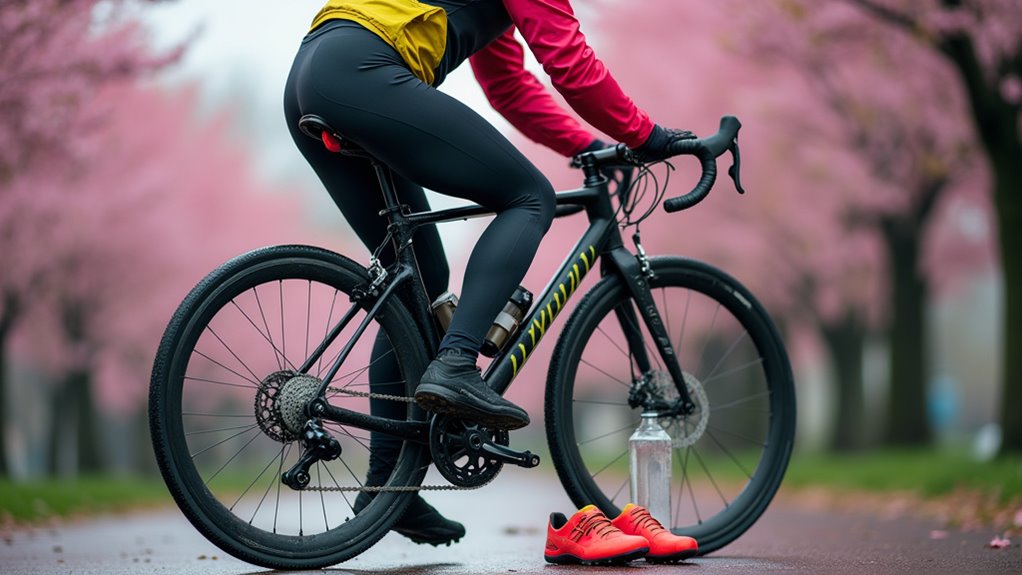
When you hit the road this spring, staying dry is key to comfort.
Investing in a quality waterproof jacket and checking the weather forecast before your ride can save you from unexpected downpours.
Don’t forget to pack lightweight rain gear, so you’re always prepared for changing conditions. Additionally, consider using a portable camping toilet to ensure comfort during breaks on longer rides.
Importance of Waterproof Gear
Staying dry is essential for maximizing your comfort while cycling in unpredictable spring weather. Investing in a high-quality cycling rain jacket is vital, as it shields you from moisture and wind chill. Look for features like breathability and packability to easily store it in your jersey pocket or saddle bag.
| Waterproof Gear | Key Features | Benefits |
|---|---|---|
| Cycling Rain Jacket | Durable, breathable | Keeps you dry and comfortable |
| Rain Pants | Lightweight, packable | Protects legs in wet rides |
| Waterproof Shoe Covers | Blocks wind, retains warmth | Keeps toes dry and cozy |
Always check weather apps before your ride and carry waterproof gear to prepare for unexpected rain. Additionally, having proper sizing for your gear can significantly enhance your comfort during rides in changing conditions.
Weather Preparedness Strategies
To enjoy your spring rides, you need to be ready for whatever the weather throws at you. Invest in a good-quality cycling rain jacket; staying dry is essential for comfort during unpredictable spring weather.
Always check weather apps before your rides and keep a lightweight, stashable jacket in your jersey pocket or saddlebag, just in case.
Arm and leg warmers help maintain warmth, so choose high-quality brands and avoid using the dryer for longevity.
Don’t forget shoe covers; silicone or rubberized options work best in wet conditions to block wind.
Regular gear maintenance—cleaning and inspecting your rain jacket, warmers, and shoe covers—ensures they’re functional for all your cycling events.
Stay prepared, and you’ll ride comfortably, rain or shine!
Strength Training for Cyclists
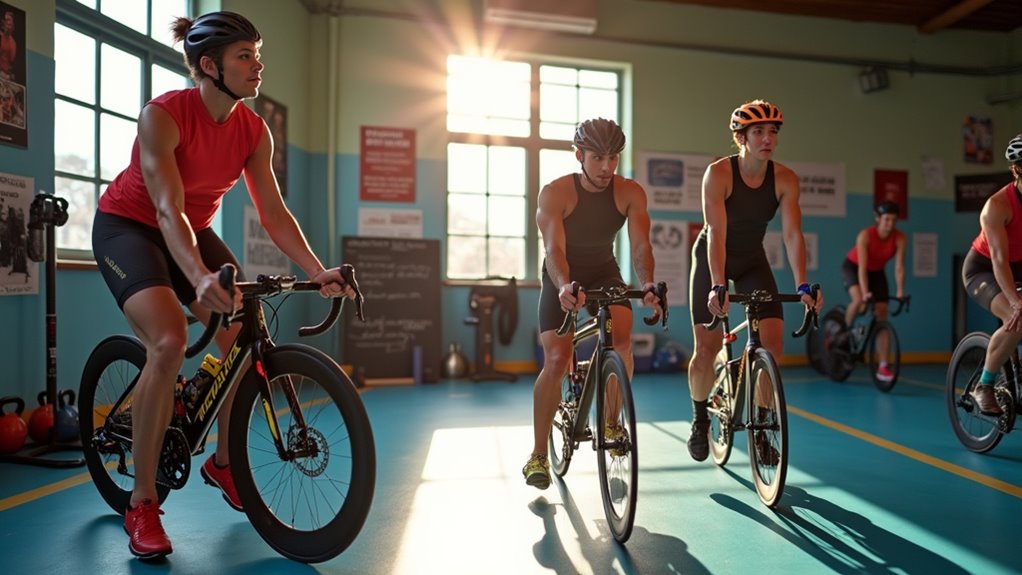
Strength training boosts your cycling performance by enhancing muscle endurance, power, and stability on the bike. Incorporating a few strength training sessions each week can greatly improve your efficiency and help prevent injuries.
Focus on:
- Core exercises like planks to enhance posture
- Squats and lunges to build leg strength
- Upper body workouts for better bike control
- Stretching routines to promote flexibility
Research shows that cyclists who commit to strength training can see a 5-10% improvement in performance, especially in hill climbing and sprinting.
By targeting specific muscle groups, you’ll not only enhance your cycling endurance but also address any physical weaknesses, leading to a more balanced and powerful ride overall.
Don’t underestimate the impact of strength training on your cycling journey!
Cross-Training Techniques
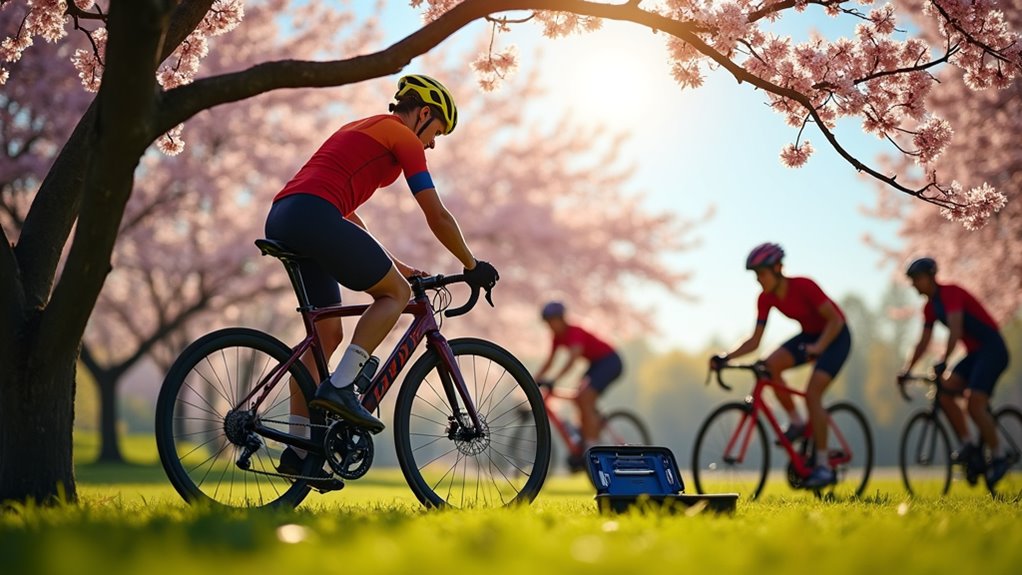
Cross-training is a game-changer for your cycling routine.
By mixing in activities like swimming, yoga, or bodyweight exercises, you’ll boost your overall fitness and reduce the risk of injuries. Incorporating low light office plants into your environment can also enhance your recovery and focus during cross-training workouts.
Let’s explore how these varied workouts can enhance your cycling performance this spring.
Benefits of Cross-Training
While many cyclists focus solely on biking to improve their performance, incorporating cross-training techniques can make a significant difference in your overall fitness.
By mixing different workouts, you can enhance your Strength and Endurance while targeting muscle groups often neglected during cycling.
Here are some key benefits of cross-training:
- Reduces the risk of overuse injuries through varied workouts
- Improves flexibility and balance, vital for cycling posture
- Boosts cardiovascular fitness with low-impact activities like swimming or hiking
- Enhances power and endurance through strength training exercises for the upper body
Incorporating activities that promote cardiovascular fitness can lead to improved stamina during long rides.
Integrating these techniques into your routine not only improves your cycling performance but also keeps your training fresh and engaging.
Make cross-training a part of your spring prep!
Activities for Varied Fitness
To enhance your cycling performance, consider incorporating varied fitness activities into your routine. Cross-training with low-impact activities like swimming, yoga, or Pilates improves flexibility and balance, essential for good riding posture.
Bodyweight exercises such as planks and squats strengthen your core and glutes, boosting cycling power and endurance. On rest days, engage in light hiking to work different muscle groups and prevent overuse injuries.
Additionally, using indoor cycling setups for interval training can elevate your cardiovascular fitness, especially when the weather’s not ideal. By gradually increasing mileage during your rides and combining these activities, you’ll reduce soreness and injury risk while allowing your body to adapt to longer distances and continuous cycling movement. Furthermore, incorporating Leave No Trace principles into your outdoor activities promotes sustainability and respect for nature.
Gradually Building Endurance for Longer Rides
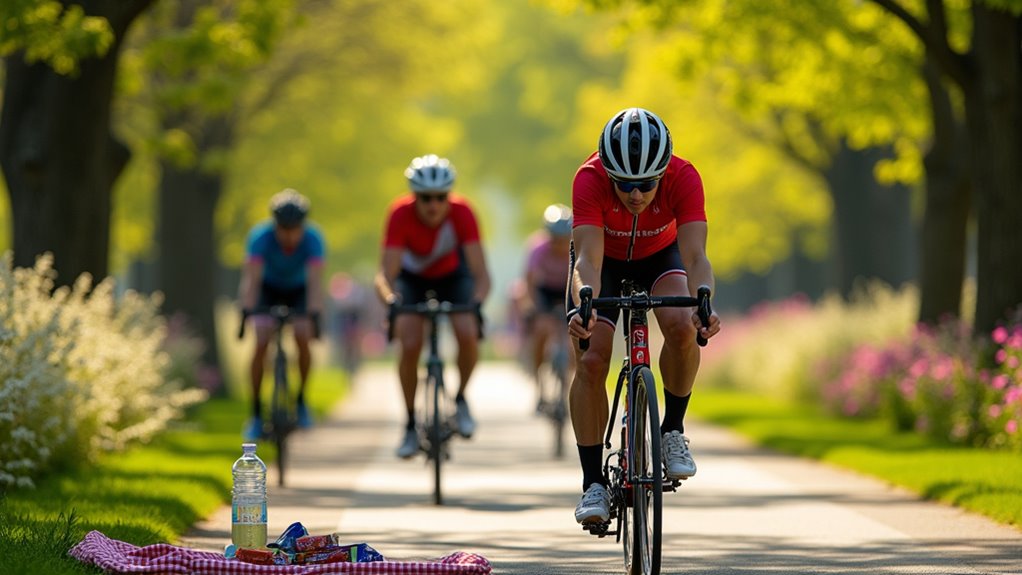
As you prepare for longer rides this spring, it’s essential to build your endurance gradually to avoid injury and guarantee a smooth progression. Here are some strategies to help you:
- Increase your ride distance by no more than 10% each week to allow your body to adapt.
- Mix short, moderate, and long rides throughout the week for balanced endurance training.
- Include at least one long ride weekly, starting with a comfortable distance and extending it as you improve.
- Use a pacing strategy, maintaining a steady effort during longer rides to prevent fatigue.
Listen to your body and don’t hesitate to take rest days.
Recovery is just as important for building endurance effectively and ensuring you enjoy your cycling adventures this spring!
Frequently Asked Questions
What Is the 75 Rule in Cycling?
The 75 Rule in cycling means you should aim to ride at least 75% of your weekly mileage at an easy, conversational pace. This approach helps you build endurance and recover effectively while avoiding burnout.
By balancing high-intensity workouts with low-intensity rides, you enhance your aerobic base and improve overall performance.
Following the 75 Rule allows you to accumulate volume without excessive fatigue, making your training more sustainable and enjoyable in the long run.
How to Prepare a Bicycle for Spring?
To prepare your bicycle for spring, start by inspecting the tires for any cracks or slits and inflate them to the recommended PSI.
Check and tighten all bolts with a torque wrench, especially those in hard-to-see areas.
Clean the frame and drivetrain, looking for any defects.
Test your brakes for effective stopping power, and listen for any rubbing sounds.
Finally, verify your cycling gear, like spare tubes and tools, is ready for your first ride.
What Not to Eat Before Cycling?
Before cycling, avoid heavy, greasy foods that cling to your stomach like a stubborn shadow, slowing down your ride.
Steer clear of high-fiber options, which can cause bloating, and limit dairy if you’re lactose intolerant—stomach cramps aren’t your friend.
Skip sugary snacks that lead to energy crashes, and don’t overdo caffeine; it’ll leave you jittery and dehydrated.
Stick to light, easily digestible snacks for a smoother, more enjoyable cycling experience.
How Do I Prepare My Body for Cycling?
To prepare your body for cycling, start by gradually increasing your mileage, aiming for a 10% distance increase each week.
Incorporate strength training exercises like planks and squats two to three times a week to enhance your core stability.
Don’t forget to cross-train with activities like swimming or yoga to improve flexibility.
Maintain a consistent schedule with high-intensity intervals and prioritize rest days for ideal recovery and performance.
Conclusion
As you gear up for spring cycling, think of yourself as a well-tuned machine, ready to hit the open road. By ensuring your bike is in top shape, layering effectively, and incorporating strength training, you’re setting the stage for a season of exhilarating rides. Embrace the journey of gradually building your endurance, allowing your passion for cycling to blossom like flowers in spring. Get out there, enjoy the fresh air, and feel the wind on your face!











